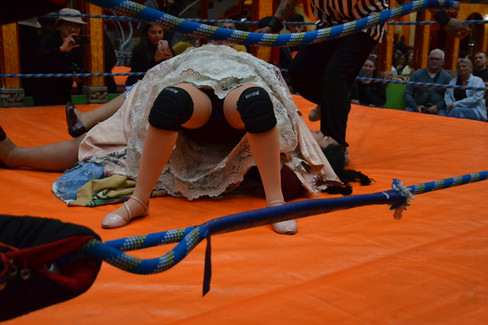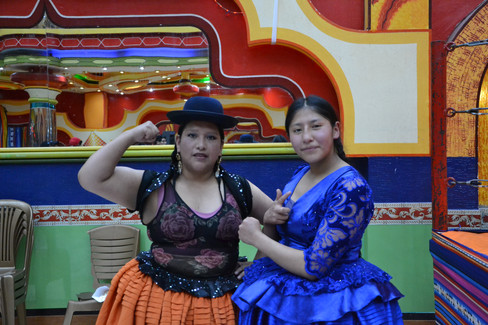Cholita wrestling in La Paz : meeting with Elizabeth La Roba Corazon, cholita luchadora
- Blogoculaire
- May 10
- 8 min read
Updated: May 17
Intro
Having discovered the discipline of lucha libre de cholitas while preparing my trip, I wanted to find out more and meet, interview and photograph one of its heroines during my journey. So it wasn't long before I came across the profile of Elizabeth La Roba Corazones (real name Veronica), one of the discipline's greatest champions, on Instagram. I contacted her to let her know I was interested in meeting her, and she was immediately enthusiastic and friendly!
Then I almost ruined everything: at the end of January 2025, we were due to meet during my first visit to La Paz. But when I arrived by plane from Buenos Aires the evening before, soroche (altitude sickness, common in the Andes) affected me like never before for more than 24 hours in the highest capital in the world... Enormous headache, and no breath or energy.
So I cancelled the appointment at the last minute. Especially as, after our interview, the plan was for me to go and see Elizabeth get into the ring in El Alto, the town where all the fights take place, and aptly named since this former 'suburb' of La Paz (now home to nearly 1 million inhabitants) is perched at an altitude of 4150m...
She'd blamed me, especially as she'd made all the arrangements for the interview, having her daughter looked after by her mother, and making sure she got to the meeting place on time, to put to rest the reputation of Latinos for not being punctual (she told me afterwards), not having got my message... I was biting my fingers!
After apologising profusely, I managed to make it up to her, and the meeting finally took place at the end of February 2025, in a cosy café in La Paz! Then I met up with her again 2 days later to photograph her on the way to El Alto, and see her on "stage" at the Cholet Ratchet where the fight was taking place.
The following article is based on Elizabeth's interview and my research on the subject. The photos and videos are those I took at the Cholet Ratchet show.
Who are the cholitas?
These are indigenous women, often of Aymara or Quechua origin, found in Peru and probably even more so in Bolivia.
In the past, these women were (are?) often, unfortunately, scorned and discriminated against. Because they were often poor, often came from rural areas to the city to live off what they opuld sell, often didn't speak Spanish very well, and didn't necessarily know how to read or write. They were often employed as domestic servants by the aristocratic Spanish occupiers.
Their typical clothes: a thick, voluminous skirt (the pollera), a bowler hat, an embroidered shawl, long straight black hair plaited in braids (often linked by tullmas), and often gold or silver teeth.
Polleras have become symbols of the cholitas, even though, ironically, they were originally clothes brought by the Spanish colonists.
There are, of course, many variations depending on the region: skirts are logically shorter in the hottest areas, such as Santa Cruz or Cochabamba, hats change shape, fabrics change colour, depending on the know-how of each region, and so on...
Elizabeth's mother didn't dress like a cholita (to avoid discrimination?), but her grandmother did.
Since the 2000s, the cholitas have been gradually taking over
The story goes that they used to be banned from many places: banks, certain places, aeroplanes (or they had to dress differently). Their image as servants/maids stuck to them.
Despite everything, the cholitas have always been strong women. Facing adversity and difficult conditions with tenacity and courage. Far from the very macho image of the gentle, obedient, precious, fragile woman.
According to Elizabeth, the situation has improved for Bolivian cholitas since the gas war (a social struggle initiated in 2003 to nationalise Bolivian gas which led to effective nationalisation in 2006), and then to the election as President of Bolivia of Evo Morales (President from 2006 to 2019).
As an indigenous Aymara himself, Evo Morales was largely elected by the indigenous populations and remains very popular with them overall.
Rightly or wrongly, since he now deeply divides Bolivians, notably because he is accused (and unfortunately this seems to be widely proven) of having abused at least 3 minors under the age of 15 when he was President. Underage girls, often from very modest backgrounds, from precisely the populations he was supposed to be defending... And in particularly sordid conditions...
Since then, the "mujeres de pollera" (women in skirts), as they are also known, have gradually gained visibility and positions that were previously almost inaccessible to them: in government, as ministers (as in the case of the current Minister of Culture), TV presenters and singers.
In a country where women are (far too often) the victims of domestic violence (the country being one of the worst in the world in this respect), and where cholitas have all too often been oppressed and discriminated against, taking up traditionally exclusively male sporting disciplines is of course a way for women to take power and assert themselves.
And it is in this context that the cholitas have infiltrated disciplines such as football.
Or skateboarding (see the Imilla Skate collective of Cochabamba skateboarding cholitas, whose Deisy Tacuri I was lucky enough to interview during my visit to Cochabamba in early March 2025 - article soon available!)
And of course the lucha libre discussed here
At the same time, and this is not necessarily contradictory, cholitas are adopting more feminine "codes": they wear make-up, perfume and jewellery...
Origins of the cholitas wrestling (lucha libre de cholitas)
The discipline, which emerged in the early 2000s in the town of El Alto (a former dormitory suburb of La Paz where most of the indigenous Aym
aras from the Bolivian countryside arrived, now a town in its own right) is directly inspired by Mexican lucha libre (which itself derives from wrestling) for its theatrical / exaggerated and acrobatic side.
Except that the "luchadoras" are rarely masked, and that they are dressed in traditional cholita garb to fight (including the famous pollera (skirt) and petticoats!
Another special feature is that a fight is always between a "good girl" character and a "bad girl".
It was around 2005 that the sport became more popular, particularly when the wrestlers decided to use pseudonyms, as for instancd "Juanita la cariñosa" (Juanita the cuddly one) and "Claudina la maldita" (Claudine the cursed one) for the 2 historical wrestlers
A discipline that is not the financial godsend it seems to be
Before Covid, Elizabeth earned her living solely from fighting.
She then stopped for several years, in particular to recover from the sadness of the death of her father following an illness and a number of operations.
She didn't start up again until the end of 2023, generally fighting 2 times a week, every Thursday and Sunday in El Alto. Not to mention the private shows she sometimes takes part in for people with a lot of money who want to see a show but can't make the public ones. Or events like Electro Preste, a big fusion festival combining electronic music and indigenous traditions (ch'allas, cholitas, etc.) organised in La Paz, where she was invited in 2025.
And to stay at the top, Elizabeth also trains 3 times a week, from 2pm to 8pm...As in wrestling, the blows are real, and the most important thing is to practise regularly, know how to fall well, breathe properly when falling, etc.
But unfortunately since Covid, she has had to find another job to get by. She now also works as an office assistant in the public sector.
And she currently lives with her mother, her 8-year-old daughter (Isabella) and her 30-year-old sister (it should be noted that in Latin America it is common for people from several generations of the same family to live under the same roof, as inter-generational solidarity is much more developed there - and financial difficulties are unfortunately even more frequent).
Travel, travel...
Her deceased father was a driving force in her luchadora career and was very supportive, instilling in her the importance of training and discipline. And the family was close to Benjamin, one of the main promoters of lucha libre in Bolivia, organising fights with the Cholita Wrestling Show.
As she has always been a sportswoman (she played basketball, volleyball and swam), it all came quite naturally.
She became NWA (National Wrestling Association) Women's Champion in 2019 and was also Cholita de Oro in 2024.
But what really motivated Elizabeth to excel in this discipline was the desire to travel to other countries.
In 2009, she was lucky enough to travel to Colombia. She also travelled to Ecuador, the United States and Lima, Peru, where her best memory is seeing the sea for the first time in her life.
As a reminder, Bolivia has no sea, the country having lost its 400 km of coastline in the Pacific War of 1879-1883 against Chile... which is still a very palpable wound in the country, where el dia del Mar is celebrated every year on 23 March, with large military parades in La Paz.
Mexicans do it better
It's clear that Mexico, the country that created the lucha libre from which the cholitas luchadoras draw their inspiration, remains a strong influence for Elizabeth.
Her best memory is of the Coliseo Cerrado, one of the largest arenas in the centre of La Paz, where the cholitas fought against Mexican luchadores with great acclaim from the public and the press.
The luchadora she admires most: another Mexican, Faby Apache.
His dream would be to travel to Mexico to meet and fight Mexican lucha libre champions.
She would also very much like to discover Japan, another very important country in the world of wrestling and lucha libre, and renowned for its followers of a discipline that is a priori rather brutal and extreme.
One of Elizabeth's proudest achievements (and that of her family!) is to have played in a famous Mexican narco telenovela, La Reina del Sur
So, are you ready to see a show when you visit Bolivia?
Practical information about attending a show
All shows take place in El Alto, according to the following schedule:
- Thursdays from 5pm at Cholet Ratchet (mainly for foreigners)
- Sundays, at the Coliseo 12 de Octubre in La Paz at 4.30pm (with a mixed audience of locals and foreign tourists)
The shows last around 2 hours and are always structured into 4 sessions:
- A 1st session with men (more classic lucha libre)
- 3 women's sessions (in cholitas luchadoras mode)
Given the growing popularity of the cholitas luchadoras, tickets can be purchased through tourist agencies as a package (entrance - including drinks and goodies - and return bus journey from your accommodation in La Paz, costing 15-20 euros).
For a more authentic and original experience, I recommend contacting Elizabeth (on WhatsApp at +591 76 72 83 50), who will be delighted to act as your tour guide and accompany you to show you El Alto before the show!
An original way to discover the city and the discipline!
And more generally, I advise you to :
- attend the Sunday shows (so you're not just tourists)
- go by your own means (the teleferico is so much more pleasant) and take the opportunity to walk around the town of El Alto beforehand if possible, to see in particular :
o the cholets (contraction of chalet + cholo), the city's typical buildings, colourful and kitschy, symbols of the upward social mobility of the Aymara people, with facades featuring Transformers-like characters
o the famous Feria 16 de Julio, a gigantic open-air market - one of the biggest in the whole of Latin America - selling just about everything (from second-hand clothes, sometimes very specific, like "Korean coats", to car parts, llama foetuses for ceremonies or pirate films, computer parts...) - it's well worth the diversions!
For the anecdote, Elizabeth had just warned me that a few weeks after our meeting, some of her compatriots were going to record a story about her... they were colleagues from Envoyé Spécial (one of french most famoust documentary program)
You can watch the replay through the link below (if you have a VPN...) - as of 1h29 min till the end :
.png)

















































































